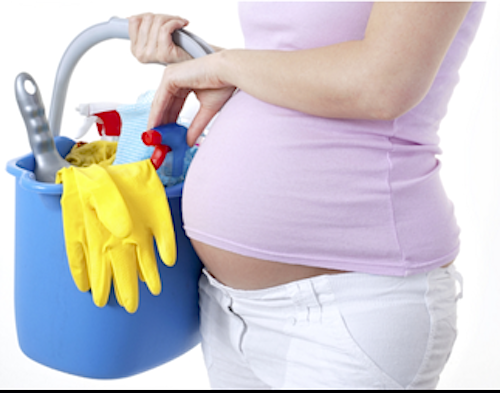|
|
Developmental Biology - Learning Delays
Household Chemicals Linked to Child Language Delay
Young children in low income homes frequently likely to show delay in language development by age 2...
Young children from low-income homes whose mothers report frequent use of toxic household cleaners, were more likely to show delays in language development by age 2, finds a new study.
Children also scored lower on tests of their cognitive development. Developmental delays were evident even when researchers took into account the education and income of mothers, which are also linked to children's language and cognitive skills.
Such findings are evidence for the need of pediatricians and other health care providers to counsel parents of young children to restrict use of toxic household chemicals.
"We found a significant percentage of mothers with young children may commonly expose children to toxic household chemicals. Possibly because they are unaware such materials may be harmful."
Hui Jiang PhD. Senior Research Associate and study lead author, Crane Center for Early Childhood Research and Policy, Ohio State University, Ohio, USA.
The study was published online recently in the journal Clinical Pediatrics.
The researchers used data on 190 families from the Kids in Columbus Study, a Crane Center research project that followed children born into low-income families in Columbus for five years following birth.
When the study first started, mothers were asked about their use of household chemicals such as floor and toilet cleaners and solvents during pregnancy. They were asked again when their child was 14 to 23 months old. Mothers also reported whether they had mold in the home, their use of pesticides, and sources of neighborhood pollution.
Children's language development was measured when they were between 14 and 23 months old and again when they were 20 to 25 months old. The researchers used a standardized test that examines children's understanding and expression of language - for example, recognition of objects and people, following directions, and naming objects and pictures.
Findings showed that neighborhood pollution, household mold and pesticide use were not significantly linked to child developmental outcomes. But, the more household chemicals reported after birth, lowered a child's language and cognitive outcomes by 2 years of age.
There was no link between chemical use during pregnancy and developmental outcomes, possibly as mothers reported using significantly fewer chemicals during pregnancy. Exposure to toxic chemicals increased about 30 percent when children were between 1 and 2 years old. Mothers also reported using more household chemicals following birth.
"A lot of mothers seem to know to limit exposure to toxic chemicals during pregnancy, but once their child is born, may think it is no longer a problem." Jiang adds.
But research shows, explains Laura Justice PhD, co-author of the study and professor of educational psychology at Ohio State, that the early years of a child's life are key to brain development.
"When kids reach about 2 years old, this is a peak time for brain development. If the use of toxic chemicals is interfering with that time of development, that could lead to problems with language and cognitive growth."
Laura Justice PhD, Executive Director, The Crane Center, Ohio State University, USA.
While many mothers may use household cleaners and other toxic chemicals when their children are young, low-income mothers may face unique challenges according to Jiang. For example, poorer families often live in smaller apartments where it may be more difficult to keep children away from chemicals, particularly while cleaning. Jiang also notes that as this study only analyzed the relationship between mothers' use of toxic chemicals at a specific time of later child development — as such it cannot prove a direct affect through continuous use of chemicals on developmental delay.
"More studies are needed to carefully examine the mechanisms through which household toxicants disrupt early language development. Parents need to understand the delicacy of brain development in the first several years of life — and their children's susceptibility to chemical exposure."
Hui Jiang PhD, Senior Research Associate on the project, Ohio State University, and lead author.
These findings reveal how pediatricians need to emphasize that pregnancy is not the only time for mothers to be concerned about chemical use, Justice adds.
"Parents need to understand the delicacy of brain development in the first several years of life and their children's continued susceptibility to chemical exposure," says Laura Justice.
Abstract
Considerable evidence has highlighted the heightened susceptibility of developmental delay in children from low-income homes; consequently, this study explored whether environmental toxicant exposure may be a contributing factor to disruption in language and cognitive development for children reared in poverty. Using a sample of 190 low-income mothers and their young children, mothers completed questionnaires on toxicant exposure in the home environment. Exposure to toxicants, especially pesticides, was reported by about 20% of mothers at or around pregnancy, and 30% when their children were between 1 and 2 years of age. Toxicant exposure was significantly associated with lags in language and cognition even when controlling for socioeconomic factors. Study findings highlight the importance of the American Academy of Pediatrics’ policy statements arguing for pediatricians to take a strong anticipatory guidance role in counseling parents to limit chemical exposure in the home and engage in safe storage practices.
Authors
Hui Jiang PhD, Laura M. Justice PhD; Kelly M. Purtell PhD and Randi Bates PhD, both of Ohio State.
Return to top of page.
| |
|
Mar 12 2020 Fetal Timeline Maternal Timeline News
 Research shows pediatricians need to emphasize pregnancy is not the only time for mothers to be concerned about chemical use, household toxicants may disrupt early language development as well. CREDIT stock photo/no copyright infringment intended
|



